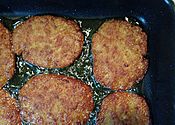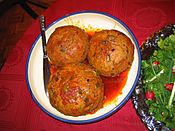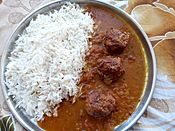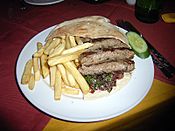Kofta facts for kids
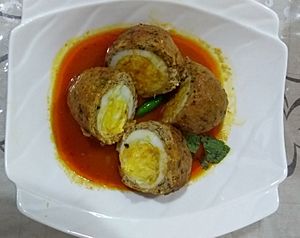
Kofta is a popular dish that's like a meatball or meatloaf. You can find it in many parts of the world, including the Balkans, the Middle East, South Caucasus, South Asia, and Central Asia.
Most often, koftas are made from minced meat. This can be beef, chicken, pork, lamb, or a mix. The meat is blended with spices and sometimes other ingredients. The very first recipes for kofta were found in old Arab cookbooks. These recipes usually used ground lamb.
Kofta comes in many different forms depending on the country or region. Some versions are even made with vegetables or can be eaten uncooked. They can be shaped like balls, flat patties, or cylinders. Their size can be anywhere from a golf ball to an orange.
Contents
What Does "Kofta" Mean?
The word kofta came into English from the Urdu language. In Urdu, it's kofta, which means "pounded meat." This word originally came from the Persian language.
The word kofta was first used in Urdu in 1665. It appeared in English for the first time in a book called Qanoon-e-Islam in 1832. Many languages in the regions where kofta is popular have similar words for it. Other foods that are similar to kofta include croquettes, dumplings, meatballs, and rissoles.
The History of Kofta
The first recipes for kofta appeared in very old Arab cookbooks. These early recipes described large meatballs made from ground lamb. They were coated three times with a mix of saffron and egg yolk, which gave them a shiny, golden look. This special coating method later spread to other parts of the world.
Kofta then traveled to India. Food writer Alan Davidson says that a dish called Nargisi Kofta was served in the royal courts of the Mughal Empire.
Today, you can find kofta in many traditional foods. It is popular from the Indian subcontinent all the way through Central Asia, the Middle East, the Balkans, and northern Africa. Countries like Iran, Afghanistan, Albania, Bulgaria, Georgia, Armenia, Azerbaijan, Greece, India, Morocco, Pakistan, Romania, and Turkey all have their own kofta dishes. In Turkey, kofta is a favorite food for all kinds of gatherings. It is also a well-loved dish among the Assyrian people.
Different Kinds of Kofta
Kofta is usually made by mixing meat with spices. Often, other ingredients are added too, like rice, bulgur (a type of cracked wheat), vegetables, or eggs. This mixture forms a paste.
Koftas can be cooked in many ways. They can be grilled, fried, steamed, poached, or baked. Sometimes, they are marinated in a sauce. They can be served with a rich, spicy sauce or added to a soup or stew.
Not all koftas are made with meat. Some versions use fish or vegetables instead. Some koftas are even stuffed with nuts, cheese, or eggs.
The size of kofta can vary a lot. Most are about the size of an orange or a golf ball. However, some are much larger, like Tabriz koftesi, which can be about 20 centimeters (8 inches) across! Koftas can be shaped in different ways, such as flat patties, round balls, or long cylinders. Some types of kofta are even eaten uncooked.
Examples of Kofta Dishes
- Chiftele: A Romanian kofta made with ground pork and mashed potatoes.
- Çiğ köfte: A Turkish and Armenian kofta made with bulgur. Sometimes, it includes raw meat.
- İnegöl köfte: A popular Turkish style of kofta.
- Islama köfte: A steamed kofta from Turkey.
- Kibbeh: A group of dishes from the Middle Eastern cuisine that includes koftas. Some types of kibbeh are served raw.
- Analı kızlı: A Turkish soup that contains small kofta balls.
- Kofta curry: This dish has meat or vegetable balls in a curry sauce. There are many types, like kofta curries made with paneer (a type of cheese), chicken, or mutton. It comes from the Indian subcontinent.
- Iranian Koftas: These include Koofteh berenji, Koofteh hamedani, Koofteh nar, Koofteh tabrizi, and Koofteh shirin-e kermanshahi.
- Nargisi kofta: An Indian dish where a hard-boiled egg is wrapped inside the kofta mixture.
- Pishtha: A type of meatball mentioned in an ancient Indian text called the Sushruta Samhita.
- Şiş köfte: A kebab-style kofta from Turkish cuisine, often cooked on a skewer.
- Sulu köfte: A Turkish kofta soup or stew.
- Tabriz köftesi: An Azerbaijani kofta that is famous for being very large, often around 20 centimeters (8 inches) wide.
- Tomatokeftedes: A Greek vegetarian kofta made with tomatoes.
Images for kids
-
Iranian Tabrizi kofta often includes yellow split peas and potatoes, along with minced meat.
hu:Török konyha#Húsgombócok
See also
 In Spanish: Kofta para niños
In Spanish: Kofta para niños


